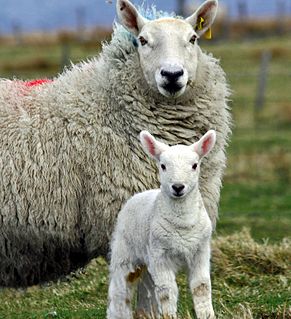 W
WThe Boreray, also known as the Boreray Blackface or Hebridean Blackface, is a breed of sheep originating on the St Kilda archipelago off the west coast of Scotland and surviving as a feral animal on one of the islands, Boreray. The breed was once reared for meat and wool, but is now used mainly for conservation grazing. The Boreray is one of the Northern European short-tailed sheep group of breeds.
 W
WThe Castlemilk Moorit is a rare breed of domestic sheep originating in Dumfriesshire in Scotland.
 W
WThe Cheviot is a breed of white-faced sheep which gets its name from a range of hills in north Northumberland and the Scottish Borders. It is still common in this area of the United Kingdom, but also in north west Scotland, Wales, Ireland and the south west of England, as well as more rarely in Australia, New Zealand, Norway (2%), and the United States. The Cheviot is a dual-purpose breed, being raised primarily for its wool and meat.
 W
WNorth Country Cheviot is a common breed of sheep raised mainly for meat production. Originated from Scotland.
 W
WThe North Ronaldsay or Orkney is a breed of sheep from North Ronaldsay, the northernmost island of Orkney, off the north coast of Scotland. It belongs to the Northern European short-tailed sheep group of breeds, and has evolved without much cross-breeding with modern breeds. It is a smaller sheep than most, with the rams (males) horned and ewes (females) mostly hornless. It was formerly kept primarily for wool, but now the two largest flocks are feral, one on North Ronaldsay and another on the Orkney island of Auskerry. The Rare Breeds Survival Trust lists the breed as "vulnerable", with fewer than 600 registered breeding females in the United Kingdom.
 W
WThe Blackface or Scottish Blackface is a British breed of sheep. It is the most common sheep breed of the United Kingdom. Despite the name, it did not originate in Scotland, but south of the border.
 W
WThe Scottish Dunface, Old Scottish Short-wool, Scottish Whiteface or Scottish Tanface was a type of sheep from Scotland. It was one of the Northern European short-tailed sheep group, and it was probably similar to the sheep kept throughout the British Isles in the Iron Age. By the mid-nineteenth century it had mostly been displaced by the Scottish Blackface and it became extinct on the mainland of Scotland in the late nineteenth century. However, several local types of Dunface survived on islands around Scotland, giving rise to or contributing to existing breeds including the Shetland, North Ronaldsay, Hebridean and Boreray.
 W
WThe Shetland is a small, wool-producing breed of sheep originating in the Shetland Isles, Scotland but is now also kept in many other parts of the world. It is part of the Northern European short-tailed sheep group, and it is closely related to the extinct Scottish Dunface. Shetlands are classified as a landrace or "unimproved" breed. This breed is kept for its very fine wool, for meat, and for conservation grazing.
 W
WThe Soay sheep is a breed of domestic sheep descended from a population of feral sheep on the 100-hectare (250-acre) island of Soay in the St Kilda Archipelago, about 65 kilometres (40 mi) from the Western Isles of Scotland. It is one of the Northern European short-tailed sheep breeds.